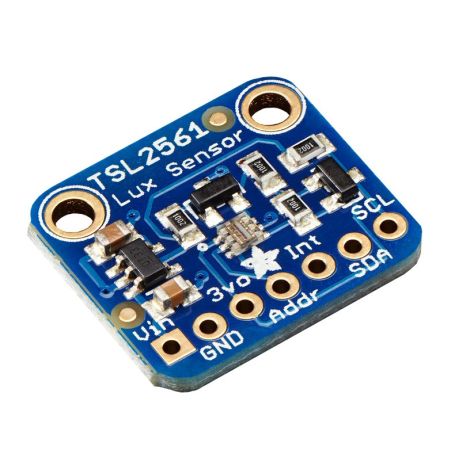DEPRECATED : TSL2561 - Lux/Luminosity/Light digital sensor
DEPRECATED: A digital sensor to accurately measure light in the visible spectrum and the rest of the spectrum!
Payments are secured by LyraCollect, a French payment collection company.
It is possible to delivered to your home, to a pick-up point or picked up by appointment at MCHobby
We prepare, pack and ship your orders with great respect and care.
Le TSL2561 is now DEPRECATED and officially replaced by the TSL2591.
TSL2561 - Lux sensor to measure luminosity
The TSL2561 light sensor is an advanced light sensor, ideal for use in a wide range of light application. This sensor is more accurate than a photo resistance (CdS) and allows an accurate calculation of brightness (in lux). It can be configured for different gains/timing ranges to detect light on the fly between 0.1 and more than 40,000 Lux.
New: since November 24, 2014, we are distributing a version including a 3.3V regulator and 3-5V "level shifter" (logic level matching circuit). So you can use this TSL2561 with any 3 or 5v micro-controller.
The greatest interest of this sensor lies in the fact that it contains two diodes: one infrared and one for the entire light spectrum! This means that you can separately measure infrared light, the entire spectrum or visible light (by us humans). Most sensors can measure one or the other... which doesn't faithfully reproduce what the human eyes perceive (since the human eyes don't perceive the infrared yet detected by most photo diodes).
This sensor has an interface (I2C). You can select one of three available addresses, which means that you can connect 3 to a single board - each with a different I2C address. The internal Analog/Digital converter allows it to be used with any micro-controller, even if it doesn't have an analog input. Current consumption is extremely low, which is why it is particularly suitable for data logging system. About 0.5mA when the sensor is active and less than 15µa when in standby.
Technical details
- Approach the response of the human eye
- Precisely measures the brightness in different light conditions.
- Temperature range: -30 to 80 °C
- Dynamic measurement range (Lux): 0.1 to 40,000 Lux
- Voltage range: 2.7-3.6V
Includes a 3.3V regulator and a 3-5V Level Shifter for use with 3 & 5 volts micro-controller - Interface: I2C
This component uses the 7-bit I2C address 0x39, 0x29, 0x49 (selectable using jumper to weld) - TSL2561 data sheet.
Tutorial
- Tutorial TSL2561 in French (on the Wiki of MCHobby)
- Tutorial TSL2561 for Arduino (AdaFruit, English)
- Lux meter - Light measurement with Arduino (AdaFruit, English)







